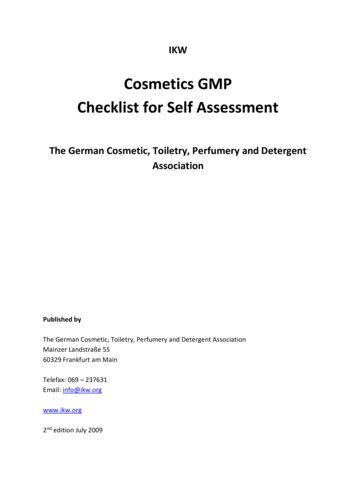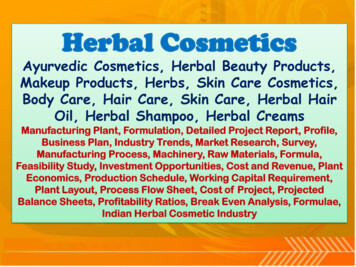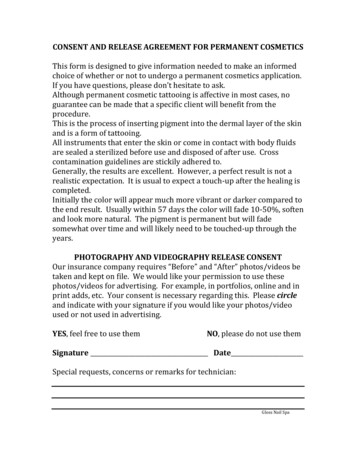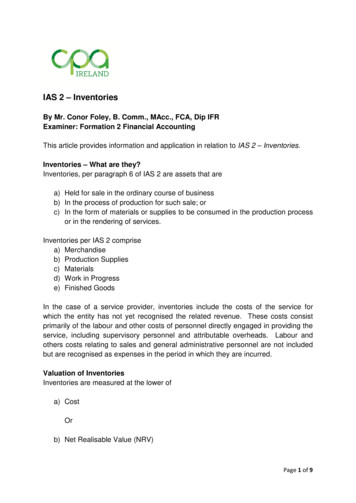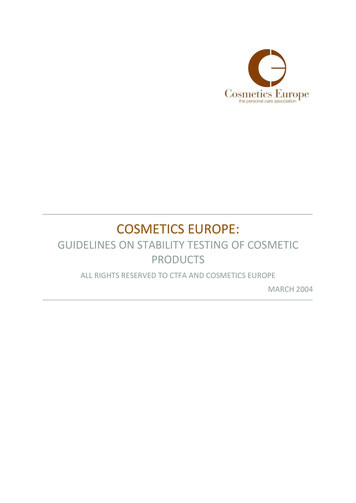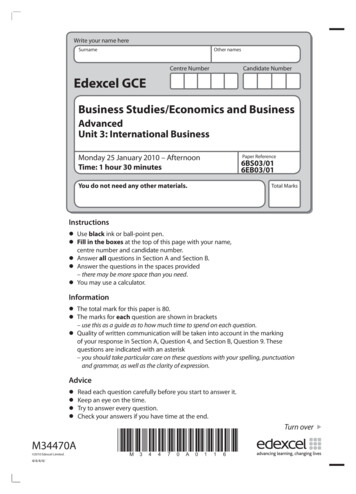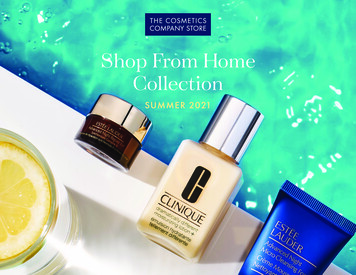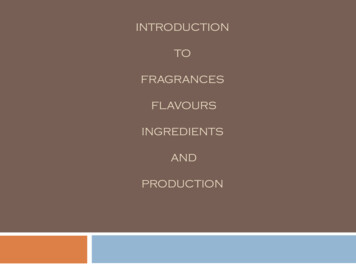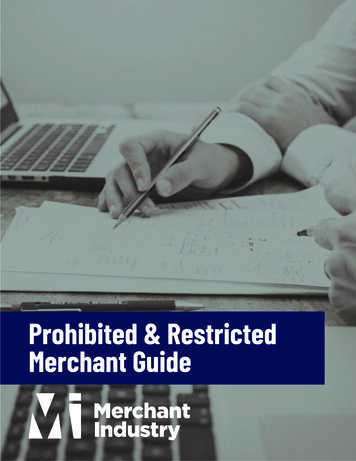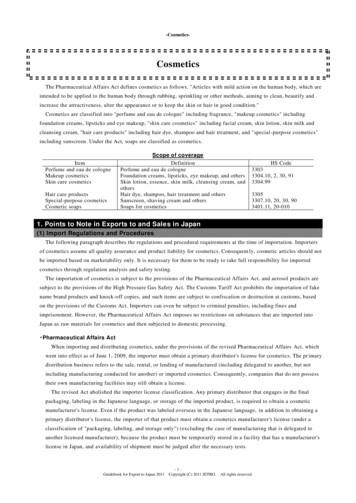
Transcription
-Cosmetics-CosmeticsThe Pharmaceutical Affairs Act defines cosmetics as follows. "Articles with mild action on the human body, which areintended to be applied to the human body through rubbing, sprinkling or other methods, aiming to clean, beautify andincrease the attractiveness, alter the appearance or to keep the skin or hair in good condition."Cosmetics are classified into "perfume and eau de cologne" including fragrance, "makeup cosmetics" includingfoundation creams, lipsticks and eye makeup, "skin care cosmetics" including facial cream, skin lotion, skin milk andcleansing cream, "hair care products" including hair dye, shampoo and hair treatment, and "special -purpose cosmetics"including sunscreen. Under the Act, soaps are classified as cosmetics.ItemPerfume and eau de cologneMakeup cosmeticsSkin care cosmeticsHair care productsSpecial-purpose cosmeticsCosmetic soapsScope of coverageDefinitionPerfume and eau de cologneFoundation creams, lipsticks, eye makeup, and othersSkin lotion, essence, skin milk, cleansing cream, andothersHair dye, shampoo, hair treatment and othersSunscreen, shaving cream and othersSoaps for cosmeticsHS Code33033304.10, 2, 30, 913304.9933053307.10, 20, 30, 903401.11, 20-0101. Points to Note in Exports to and Sales in Japan(1) Import Regulations and ProceduresThe following paragraph describes the regulations and procedural requirements at the time of importation. Importersof cosmetics assume all quality assurance and product liability for cosmetics. Consequent ly, cosmetic articles should notbe imported based on marketability only. It is necessary for them to be ready to take full responsibility for importedcosmetics through regulation analysis and safety testing.The importation of cosmetics is subject to the provisions of the Pharmaceutical Affairs Act, and aerosol products aresubject to the provisions of the High Pressure Gas Safety Act. The Customs Tariff Act prohibits the importation of fakename brand products and knock-off copies, and such items are subject to confiscation or destruction at customs, basedon the provisions of the Customs Act. Importers can even be subject to criminal penalties, including fines andimprisonment. However, the Pharmaceutical Affairs Act imposes no restrictions on substances that are imported intoJapan as raw materials for cosmetics and then subjected to domestic processing.・Pharmaceutical Affairs ActWhen importing and distributing cosmetics, under the provisions of the revised Pharmaceutical Affairs Act, whichwent into effect as of June 1, 2009, the importer must obtain a primary distributor's license for cosmetics. The pr imarydistribution business refers to the sale, rental, or lending of manufactured (including delegated to another, but notincluding manufacturing conducted for another) or imported cosmetics. Consequently, companies that do not possesstheir own manufacturing facilities may still obtain a license.The revised Act abolished the importer license classification. Any primary distributor that engages in the finalpackaging, labeling in the Japanese language, or storage of the imported product, is required to o btain a cosmeticmanufacturer's license. Even if the product was labeled overseas in the Japanese language, in addition to obtaining aprimary distributor's license, the importer of that product must obtain a cosmetics manufacturer's license (under aclassification of "packaging, labeling, and storage only") (excluding the case of manufacturing that is delegated toanother licensed manufacturer), because the product must be temporarily stored in a facility that has a manufacturer'slicense in Japan, and availability of shipment must be judged after the necessary tests.Guidebook for Export to Japan 2011-1Copyright (C) 2011 JETRO.All rights reserved.
-Cosmetics-[Primary distributor's license]Primary distributor's license applications are filed with the competent prefectural pharmaceutical affairs divisionwith jurisdiction over the business office where the marketing supervisor-general serves. Licenses are to berenewed every five years. Applicants must conform to the Good Quality Practice (GQP) standards and GoodVigilance Practice (GVP) standards, and they must appoint a marketing supervisor -general. The Act clearly assignsresponsibility to primary distributors to assure post-marketing product quality, and to undertake appropriate actionsfor safety management. Applicants are required to obtain a business code number in advance. Documents require dfor application include a copy of the corporate registration (in the case of a corporation), a list of the segregation ofduties, a medical certificate attesting an applicant, documents certifying the qualifications of the marketingsupervisor-general and an employment contract, documents verifying the quality management system and thepost-marketing safety management system, a floor plan of the business office and storage facility, and others.Application for a cosmetic manufacturer's license (under the classification of "packaging, labeling, and storageonly") requires an outline of the physical facility, a floor plan of the manufacturing facility, documents certifyingthe qualifications of the responsible engineering manager and an employment contract, a copy of any contract witha testing laboratory (when used).After obtaining the primary distributor's license but before initiating product importation, the primarydistributor must file a Notification form of cosmetic manufacture or importation brand name (with thePharmaceutical and Medical Devices Agency (PMDA)), the Notification form of primary distribution of cosmetics(with the same prefecture as that which has granted the primary distributor's license), and the Import notificationform of cosmetics for primary distribution (with the Kanto-Shinetsu Regional Bureau of Health and Welfare, or theKinki Regional Bureau of Health and Welfare). Either they must attach to those forms an ingredients list from theimport supplier manufacturer or, if this list cannot be obtained, a record of the testing and inspection resultsverifying that the product does not contain any prohibited combination.[Approval for primary distribution by product category]The Cosmetics Standards (Ministerial Notification in September 2000) defines the ingredients that are subject toprohibition or restriction in cosmetics combinations, and those that are allowed in cosmetics combinations inspecific ingredient groups. Antiseptics, ultraviolet ray absorbents and tar coloring are sub ject to a positive list thatindicates the maximum mixture quantities. All other ingredients may be used in cosmetics combinations after thesafety verification and selection at their own liability, except those covered by a negative list of combinations thateither prohibits or limits them. In this regard, however, all ingredient names must be listed in the labeling.Provided the ingredients do not violate the Cosmetics Standards and all the ingredients are indicated on thelabeling, approval for primary distribution by product item is not required. However, products containing amountsof ingredients in excess of the notifiable limit, or new ingredients without a history of prior usage, or which containnon-disclosed ingredients, must obtain primary distribution approval for each product item.[Preparation and maintenance of quality standard statement]Primary distributors are required to properly evaluate the results of production management and the qualitycontrol of cosmetics to be actually distributed, decide whether to ship to the market by lot, and prepare the records(quality standards) regarding whether to and where to ship the cosmetics. They must retain these records for fiveyears.In addition, primary distributors of cosmetics must establish a s ystem capable of providing accurate informationin response to consumer inquiries, along with a system for handling complaints about product quality and the like aswell as product recalls. They shall prepare and retain records required for the foregoing. Furthermore, if the primarydistributor becomes aware of a research report indicating that one of the cosmetic product imports may have aharmful effect, the primary distributor must report that fact to the Mi nister of Health, Labour and Welfare within 30Guidebook for Export to Japan 2011-2Copyright (C) 2011 JETRO.All rights reserved.
-Cosmetics-days.・High Pressure Gas Safety ActAerosol products (e.g., hair spray) must be separately inspected at the time of importation. If the relevant productsmeet certain requirements specified under the High Pressure Gas Safety Act, however, they will be excluded from theapplication of the Act, on condition that the products describe precautions for consumers, but written results of thetests certifying that the products do not fall under the Act must be submitted to customs.(2) Regulations and Procedural Requirements at the Time of SaleThe sale of cosmetics is subject to the provisions of the Pharmaceutical Affairs Act, the High Pressure Gas Safety Act,and the Fire Service Act. In addition, cosmetics and cosmetic soaps are subject to the Act against UnjustifiablePremiums and Misleading Representations. Products that infringe on intellectual property rights are regulated by thevarious intellectual property laws (Trademark Act, Patent Act, Unfair Competition Prevention Act, etc.). Prospectiveimporters must be aware of these considerations, as rights holders may initiate legal action. Besides this, door -to-doorsales, mail-order sales, chain sales, and other specified commercial transactions are subject to the provisions of the Acton Specified Commercial Transactions. In addition, as to containers and packaging, labeling may be subject to theprovisions of the Law for Promotion of Effective Utilization of Resources, and recycling may be subject to theprovisions of the Law for Promotion of Sorted Collection and Recycling of Containers and Packaging (certainsmall-scale providers are exempted from this regulation).・Pharmaceutical Affairs ActUnder the Act, cosmetics do not require a retailer's license, so anyone may resell them without restriction. But, thesale of defective cosmetics is prohibited, such being defined as follows: products that do not conform to the CosmeticsStandards, products that are unclean, degraded in quality, which contain foreign substances, which are contaminatedwith disease-causing microorganisms, or which make use of unapproved tar coloring. In addition, the Act specifieslabeling items on the containers or packaging of cosmetics, and certain items may not appear in labeling. Products thatviolate labeling regulations are deemed to be improperly labeled cosmetics, and their sale is prohibited. Advertisingand labeling for cosmetics are also regulated under the Act.・High Pressure Gas Safety ActWhen selling products in aerosol containers, they must be labeled in accordance with the provisions of the HighPressure Gas Safety Act.・Fire Service ActProducts deemed as being hazardous under the Act are subject to the provisions of the Fire Service Act when storedin amounts in excess of certain levels or when transported over land. They are subject to notification or permissionfrom the mayor of the local municipality. Aerosol products using high concentrations of alcohol may fall under thiscategory.・Act against Unjustifiable Premiums and Misleading RepresentationsThe Act prohibits any form of improper labeling with exaggerated or false labeling that misleads consumers aboutthe nature or quality of a product. The Consumer Affairs Agency can demand d ocumentation of a rational basis forlabeling that makes claims of superior quality etc. If the importer or reseller is unable to do so, those claims areconsidered to be a form of improper labeling. Vague or confusing labeling that makes it difficult to d iscern the actualcountry of origin is also prohibited as a form of improper labeling.Based on the Act, the industry of cosmetics and cosmetic soaps has adopted the Fair Competition Code ConcerningRepresentations of Cosmetics, the Fair Competition Code Concerning Representations of Cosmetics Soaps, and theGuidebook for Export to Japan 2011-3Copyright (C) 2011 JETRO.All rights reserved.
-Cosmetics-Fair Competition Code Concerning Restrictions on Premium Offers in the Cosmetic Soap Industry, under certificationby the Consumer Affairs Agency (The jurisdiction of the Act was transferred from the Fa ir Trade Commission to theConsumer Affairs Agency in September 2009). While these are voluntary industry rules, when they are adopted basedon the Act, any breach of the Fair Competition Code is deemed to be as a breach of the Act.・Act on Specific Commercial TransactionsThe Act on Specified Commercial Transaction was enacted to ensure that specified commercial transactions such asmail-order sales and door-to-door sales of designated products, rights and services, are carried out f airly and in such away as to protect ordinary consumers. Commercial transactions specified under the Act include: [1] door -to-door sales,[2] mail-order sales, [3] telemarketing sales, [4] chain sales (Internet marketing and multilevel marketing based onword of mouth), [5] specific continuous service provision transactions, and [6] sales transactions offering businessopportunities. Mail-order sales include Internet sales and commercial advertisements through e -mail. In order toprovide consumers with accurate information, in mail-order sales, operators are required to list the followinginformation in their advertisements: [1] sale prices, [2] payment period and method, [3] delivery date, [4] clausesrelated to the return system, [5] name, address and telephone number of operator. The Act also prohibits advertisingcontaining false or exaggerated statements.(3) Contacts of Competent AuthoritiesFig. 1Related regulations andcontrolPharmaceutical Affairs ActHigh Pressure Gas SafetyActFire Service ActAct against UnjustifiablePremiums and MisleadingRepresentationsAct on Specific CommercialTransactionsLaw for Promotion ofEffective Utilization ofResources/Law forPromotion of SortedCollection and Recycling ofContainers and PackagingContacts of competent authoritiesCompetent agenciesContact/WebsiteGeneral Affairs Division, Pharmaceutical andFood Safety Bureau, Ministry of Health, Labourand Welfare(Pharmaceutical Affairs Act in general)Evaluation and Licensing Division,Pharmaceutical and Food Safety Bureau,Ministry of Health, Labour and Welfare(Marketing approval procedures)Industrial Safety Division, Nuclear and IndustrialSafety Agency, Ministry of Economy, Trade andIndustryFire and Disaster Management AgencyFire Station having jurisdiction over the addressRepresentation Division, Consumer AffairsAgencyTEL: 81-3-5253-1111(Main)http://www.mhlw.go.jpConsumer Economic Policy Division, Commerceand Information Policy Bureau, Ministry ofEconomy, Trade and IndustryRecycling Promotion Division, IndustrialScience and Technology Policy andEnvironment Bureau, Ministry of Economy,Trade and IndustryOffice of Recycling Promotion, Policy PlanningDivision, Waste Management and RecyclingDepartment, Ministry of EnvironmentTEL: 81-3-3501-1511(Main)http://www.meti.go.jpTEL: 81-3-5253-1111(Main)http://www.mhlw.go.jpTEL: 81-3501-1511(Main)http://www.nisa.meti.go.jpTEL: 81-3-5253-5111(Main)http://www.fdma.go.jpTEL: 81-3-3507-8800(Main)http://www.caa.go.jpTEL: 81-3-3501-1511(Main)http://www.meti.go.jpTEL: 81-3-3581-3351(Main)http://www.env.go.jp2. Labeling(1) Labeling under Legal Regulations・Pharmaceutical Affairs ActWhen selling cosmetics, the Pharmaceutical Affairs Act requires that the co ntainer, packaging, or package inserts ofcosmetics be labeled with the specified items so as to ensure appropriate usage and handling, ensure quality, andGuidebook for Export to Japan 2011-4Copyright (C) 2011 JETRO.All rights reserved.
-Cosmetics-clarify liability. All must be expressed in the Japanese language and must be clearly and explicitly listed. Labelingwith false or potentially misleading expressions, and unapproved claims of effect -efficacy in labeling are prohibited.The items that should be indicated for cosmetics are as follows.[Required labeling items]・ Name and address of primary distributor(Office location where the marketing supervisor-general serves; in the case of those obtained primary distributionapproval for the products manufactured in foreign countries, name and country of foreign preferen tial approvalholder, and name and address of nominated primary distributor)・ Brand name (Name for which notification has been posted for primary distribution)・ Manufacturing number or code・ List of ingredients(In principle, all ingredient names shall be listed in the labeling. Names must appear in the Japanese languagethat is readily understandable, and must normally be listed in descending order by quantity.)・ Expiration date, for a cosmetic designated by the Minister of Health, Labour and Welfare.・ Other items specified by the MHLW Ministerial Ordinance・High Pressure Gas Safety Act and Fire Service ActThe information to appear on the label, such as warnings, cautions, types and quantities of hazardous materials, andthe size of the letters and other labeling practices are set for aerosol products and other products deemed hazardousunder the High Pressure Gas Safety Act and the Fire Service Act.[Representation example]Keep away from fire and high temperatures*This is combustible product using high-pressure gas. Be sure to observe the following:1. Do not use near flames or fire.2. Do not use large amounts in rooms with open flames .3. The container may burst if exposed to high temperatures. Do not place under directsunlight or near fires or other locations of temperatures more than 40 C.4. Do not dispose of in incinerator.5. Be sure to use completely before disposal.High Pressure Gas: Type of gas used (label name of gas)* Label with white letters on red field・Law for Promotion of Effective Utilization of Resources[Representation example]Under the Law for Promotion of Sorted Collection and Recyclingof Containers and Packaging, as to specific containers and packaging,labeling must be provided, in order to promote sorted collection.When paper or plastic is used as a packaging material for thewrapping of individual product items, a material identifier mark mustExternal packagingLabelbe displayed in at least one location on the side of the container.・Voluntary labeling based on provisions of lawThere is no voluntary labeling based on the provisions of the law for cosmetics. The Japan Cosmetic IndustryAssociation has compiled a Japanese version of the "List of Cosmetic Ingredient Label Names" to be u sed inconjunction with the Pharmaceutical Affairs Act's requirement to list all ingredient names on the labeling. If a newlabel name needs to be devised, then a request can be filed with the Association.Label names shall be, in principle, translated into Japanese from the International Nomenclature of CosmeticIngredients (INCI) names published by the Cosmetic, Toiletry, and Fragrance Association (CTFA) of the UnitedGuidebook for Export to Japan 2011-5Copyright (C) 2011 JETRO.All rights reserved.
-Cosmetics-States.Contact: Japan Cosmetic Industry AssociationTEL: 81 -3-5472-2530URL: http://www.jcia.org/(2) Labeling under Industry-level Voluntary Restraint・Fair Competition Codes based on Act against Unjustifiable Premiums and Misleading RepresentationsThe Fair Competition Codes establish required labeling items for cosmetics and cos metic soaps as follows.[Representations of Cosmetics][1] Product name by type[2] Brand name[3] Name and address of primary distributor[4] Content (weight or capacity)[5] Country of origin[6] Manufacturing number or code[7] List of ingredients as required by the Minister of Health, Labour and Welfare[8] Expiration date, for a cosmetic designated by the Minister of Health, Labour and Welfare[9] Precautions on usage or storage, for a cosmetic stipulated under the Enforcement Regulation[10] Information contact[Representations of Cosmetic Soaps][1] Name and address of primary distributor[2] Brand name[3] The phrase "Soap"[4] List of ingredients as required by the Minister of Health, Labour and Welfare[5] Manufacturing number or code[6] Expiration date, for a designated cosmetic soap[7] For those products manufactured by a frame mixing method, a term to that effect[8] Standard weight per unit[9] Country of originContacts:"Fair Competition Code Concerning Representations of Cosmetics " Cosmetic Fair Trade ConferenceTEL: 81-3-5472-2533 (Main)"Fair Competition Code Concerning Representations of Cosmetics Soaps " Cosmetic Soap Fair Trade CouncilTEL: 81-3-3271-4301 (Main)・Voluntary labeling by the Aerosol Industry Association of JapanThe Aerosol Industry Association of Japan has established labeling guidelines for aerosol products. Theseguidelines mandate the following labeling for precautions on usage.[Representation example]Precautions on usage- Do not place heat-sensitive objects near heating devices (fan heaters), as there is a risk of high temperaturesleading to rupturing- To dispose of the product, take it outdoors to a location away from all flames, and press the button until thehissing sound stops, in order to exhaust all the gas.Contact: Aerosol Industry Association of JapanGuidebook for Export to Japan 2011TEL: 81-3-3201-4047-6Copyright (C) 2011 JETRO.URL: http://www.aiaj.or.jp/All rights reserved.
-Cosmetics-3. Taxation System(1) Tariff DutiesFig. 2 lists the tariffs imposed on cosmetics. To apply for preferential tariff rates on articles impo rted from countriesgranted preferential treatment, the importer should submit a certificate of preferential country of origin (Form A) issuedby the customs or other issuing agency in the exporting country (not required if the total taxable value of the a rticle doesnot exceed 200,000). For details, contact the Customs and Tariff Bureau, Ministry of Finance. When confirming thetariff classification or applicable tariff rate in advance, it is convenient to use the "advance -counseling program." Bymaking a verbal inquiry to customs, or by means of letter or e-mail, customs will duly respond with the requiredinformation.Contact: Customs website http://www.customs.go.jp/english/index.htmFig. 2Tariff duties on cosmeticsRate of dutyHS erentialSpecialpreferential000Perfumes and toilet waters5.3%FreeFreeBeauty or make-up preparations and preparations for the careof the skin (other than medicaments), including sunscreen orsuntan preparations; manicure or pedicure preparationsLip make-up preparations5.8%FreeFreeEye make-up preparations5.8%FreeFreeManicure or pedicure preparations6.6%FreeFreeOtherPowders, whether or not compressed5.8%FreeFree010Toilet powders090OtherOther5.8%FreeFreeCreams and other preparations with a basis of oil, fat or wax011Foundation creams012In liquid form019Other090OtherPreparation for use on the hairShampoos5.8%FreeFreePreparations for permanent waving or straighteni ng5.8%FreeFreeHair lacquers5.8%FreeFreeOther5.8%FreeFree010Perfumed hair oil, cream, pomade and other preparationswith a basis of oil, fat or waxOther090Pre-shave, shaving or after-shaving preparations, personaldeodorants, bath preparations, depilatories and otherperfumery (excluding articles relevant to other items)Pre-shave, shaving or after-shave preparations6.7%4.8%FreePersonal deodorants and antiperspirants5.8%3.9%FreePerfumed bath salts and other bath preparations5.8%3.9%FreeOther0101 Preparations with a basis of oils, fats or waxes5.8%4.8%Free0902 Other6.0%4.0%FreeSoap; organic surface-active products and preparations for useas soap or washing the skin, in the form of liquid or cream andput up for retail saleFor toilet use (including medicated soap)5.5%FreeFreeSoap in other forms010For toilet use (including medicated soap)5.8%FreeFree1: Special preferential rate is applicable only for the Least Developed Countries.2: Normally the order of precedence for application of tariff rat es is Preferential, WTO, Temporary, and General, in that order.However, Preferential rates are only eligible when conditions stipulated by law or regulations are met. WTO rates apply whenthose rates are lower than Temporary or General rates. Refer to "Cu stoms Tariff Schedules of Japan" (by Customs and TariffBureau, Ministry of Finance) for a more complete interpretation of the tariff table and for more details on economic partners hipagreements (EPAs) with each country.(2) Consumption Tax(CIF Tariff duties) 5%4. Trade Trends(1) Changes in Imports Trends in importation by product category Imports of cosmetics had been steadily growing until 2007, but decreased to 178.9 billion in 2008 on a value basis,Guidebook for Export to Japan 2011-7Copyright (C) 2011 JETRO.All rights reserved.
-Cosmetics-3.6% down from the year before due to the economic stagnation that could be traced to the Lehman Shock in autumn2008, and to 159.1 billion in 2009, 11% down from the year before due to consumers' reticence to buy, such that therewere year-on-year declines for two consecutive years. In 2010, imports recovered to the pre-recession 2007 level, at 185 billion, 16.3% up from the year before, due to substantial growth in imported hair care products. As in the case of avalue basis, imports in 2010 on a volume basis increased to 161,673 tons, 2 0.3% up from the year before. Thissignificant growth in hair care products is due to the fact that major foreign -affiliated manufacturers transferred theirproduction bases to Thailand and other Asian countries.In 2010, imports of hair care products registered stronger growth than those of skin care cosmetics that had driven theimported cosmetic market in the past. By product category, skin care cosmetics registered 60.62 billion, making up32.8% of all imports, the highest share. The next most prominen t product categories are hair care products ( 52.8 billion,28.5% share), makeup cosmetics ( 26.94 billion, 14.3% share), perfume and eau de cologne ( 21.26 billion, 11.5%share), and special-purpose cosmetics ( 17.97 billion, 12.2% share). Most of the product categories showed an increaseof a few percentage points from the year before, whereas hair care products registered a 75% increase from the yearbefore.Fig. 3Changes in cosmetics imports[Changes in volume imports][Changes in import values of main product categories]( Perfume and eau decologneMakeup cosmeticsSkin care cosmeticsHair care productsSpecial-purposecosmeticsCosmetic ,02324,26933,20668,01528,69119,83719,837( 0010,0000MakeupcosmeticsHair care productsPerfume and eau de cologne2006(year)Value2008Skin care cosmetics2006200720072008Volume2008200920092010 155,5976,6817,3585,4415,904 20,566 21,036 20,987 19,331 20,354171,057 185,600 178,932 159,083 185,025 130,843 136,318 134,403 134,431 161,673Units: value million, volume tonsNote: Total is not always the simple sum for each column due to rounding.Source: Trade Statistics (MOF) Import trends by country/region On a value basis, the leading exporters were France and the U.S.A., which together accounted for 49.8%, almost halfof the total, in 2009. In 2010, however, Thailand exceeded the U .S.A. and moved into second place (on a value basis),due to the fact that major foreign-affiliated manufacturers of hair care products transferred their production bases toThailand and other Asian nations.This is considered to be due to the fact that the world's leading cosmetic companies shifted their production bases toAsian countries where production costs are lower, in response to worldwide economic stagnation. As a result, the EUcommanded a 40.2% (on a value basis, 6.1 points down from the year before) of the imported cosmetic market in 2010,whereas Asia registered 38.1% (on a value basis, 8.8 points up from the year before).France has maintained its top position in the three main cosmetic sectors (perfume and eau de cologne, makeupGuidebook for Export to Japan 2011-8Copyright (C) 2011 JETRO.All rights reserved.
-Cosmetics-cosmetics, and skin care cosmetics), and also the highest total share by nation. In 2010, France's exports of perfume andeau de cologne to Japan increased to 12.56 billion (59.1% share), 5.7% up from the year before, while makeupcosmetics decreased 9.4% to 9.77 billion (51.3% share), and skin care cosmetics increased 10.8% to 24.52 billion(share 40.5%). France accounted for 26.9% of total imports, with an increase of 3.6% to 50.25 billion.The U.S.A. exhibited recovery in its leading product categories in 2010. Imports of perfume and eau de cologneregistered an increase of 5.1% from the year before to 2 billion, while makeup cosmetics increased 7.1% to 5.24billion, skin care cosmetics increased 2.0% to 16.43 billion, and hair care products increased 21.5% to 3.38 billion.Imports of hair care products from Thailand have grown rapidly, accounting for 73.7% of the tota l and increasing to 38.9 billion (2.2 times more than the year before). China stayed in fourth place in terms of total share (7.6%), achievinga two-digit increase of 11.6% from the year before to 14.13 billion in 2010. China took first place in imports ofspecial-purpose cosmetics, with an increase of 8.4% from the year before to 5.98 billion, while the U.S.A. experienceda decrease of 22.6% from the year before. This reflects an expanding split between the two nations. In
Makeup cosmetics Skin care cosmetics Hair care products Special-purpose cosmetics Cosmetic soaps Perfume and eau de cologne Foundation creams, lipsticks, eye makeup, and others Skin lotion, essence, skin milk, cleansing cream, and others Hair dye, shampoo, hair treatment and others Sunscreen, shaving c

